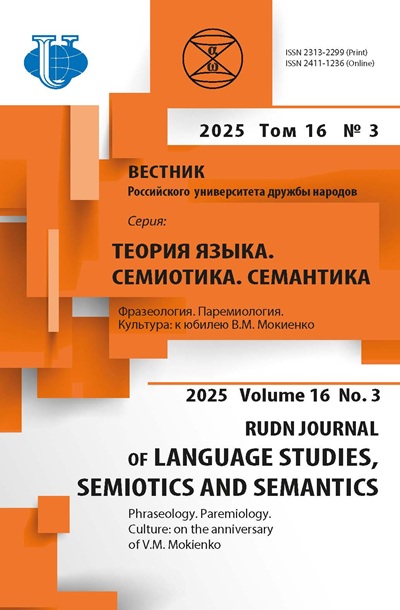ВАРИАНТЫ ФРАЗЕОЛОГИЧЕСКИХ ЕДИНИЦ, СОДЕРЖАЩИХ ТЕОНИМЫ, В АЗЕРБАЙДЖАНСКОМ ЯЗЫКЕ
- Авторы: Садыхова А.П.1
-
Учреждения:
- Азербайджанский технический университет
- Выпуск: Том 10, № 2 (2019)
- Страницы: 373-380
- Раздел: ФРАЗЕОРЕСУРСЫ
- URL: https://journals.rudn.ru/semiotics-semantics/article/view/21755
- DOI: https://doi.org/10.22363/2313-2299-2019-10-2-373-380
- ID: 21755
Цитировать
Полный текст
Аннотация
В статье предлагается рассуждение о том, что во фразеологической системе азербайджанского языка аллитерации и ассонансы по характеру проявлений менее активны, чем в других языках. Сравнительный анализ теонимов и демонимов в составных фразеологических единицах в азербайджанском языке показывает, что достаточную степень функциональности демонстрирует здесь не только наличие видов воспроизведения звука обоих звуковых повторов, но и широко распространенная совместная (аллитерационно-ассонансная) модель приемов образного фонетического изображения. Одним из ключевых пунктов обширного всесторонного, систематического исследования мифологического и демонического компонентов фразеологических единиц в азербайджанском языке является то, что в последние десятилетия коренным образом изменилось отношение к религии и религии в обществе. Методы воспитания атеистов, которые внедрялись при советской власти, и сама идеологическая доктрина атеизма надолго привели к разрыву в обществе. В советском прошлом атеизм был отдельной и обязательной дисциплиной в школьных программах, было совершенно ясно и логично осторожно относиться ко всему, что связано с религией. С этой точки зрения, нельзя говорить о объективности научного описания системы фразеологизмов, которая является одним из неотъемлемых компонентов азербайджанской лингвокультурологической среды.
Ключевые слова
Об авторах
Айтен Пилага кызы Садыхова
Азербайджанский технический университет
Автор, ответственный за переписку.
Email: sadiqovayten@gmail.com
кандидат филологических наук, преподаватель Азербайджанского технического университета
Проспект Гесейн Джавида, 25, Баку, Азербайджан, AZ 1148Список литературы
- Сеидалиев Н. Фразеология языка азербайджанских дастанов и сказок (на азербайджанском языке). Баку, 2006.
- Жирмунский В.М. Ритмико-cинтаксический параллелизм как основа древнетюркского народного эпического стиха // Вопросы языкознания. 1964. № 4. C. 3-24.
- Демирчизаде А. Стилистика азербайджанского языка. Баку: Азертедриснешр, 1962.
- Бабкин А.М. Русская фразеология, её развитие и источники. Л.: Наука 1990.
- Буслаев Ф.И. Русские пословицы и поговорки, собранные и объясненные. М.: Русский язык, 1954.
- Базарова Л.В. Конструктивный анализ фразеолосемантических полей на материале фразеологических единиц, репрезентирующих концепт Бог в английском, русском, татарском и турецком языках // Искусствоведение. 2011. Вып. 56. № 20 (235). С. 25-30.
- Базарова Л.В. Концепт Бог во фразеологических единицах английского, русского, татарского и турецкого языков: автореф. дис.. канд. филол. наук. Казань, 2011.
- Великоредчанина Л.А. Особенности функционирования библеизмов в английском и русских языках // Вестник МГОУ. Серия Лингвистика. 2012. № 1. С. 64-70.
- Гальперин И.Р. Текст как объект лингвистического исследования. М.: КомКнига, 2007.
- Долгова А.O. Какие образы-эталоны представлены во фразеологических сравнениях? // Русский язык и литература. 2006. № 7. С. 50-55.
- Григорьева Л.Л. Фразеологическая репрезентация религиозного мира человека: автореф. дис.. канд. филол. наук. Казань, 2010.
- Гизатова Г.К. Структурно-типологический подход к сопоставительному исследованию фразеологии: автореф. дис.. д-ра филол. наук. Казань, 2010.
- Дачко Е.М. Модели эвфемизации теонимов в Пятикнижии Моисеевом // Вестник ЮжноУральского государственного университета. Серия: Лингвистика. 2006. № 6 (61). C. 138-141.
- Мирзалиева М.М. Теоретические проблемы фразеологии тюркских языков. Баку, 1995.
- Мирзалиева М.М. Фразеология тюркских языков. Баку, 2009. Т. 1.
- Оруджов А.А. Азербайджанско-русский фразеологический словарь. Баку, 1976.
- Ганиева Ф.Ф. Фразеологические единицы как объект исследования в трудах отечественных исследователей // Lingua mobilis. 2015. № 1 (52). C. 38-47.
Дополнительные файлы












